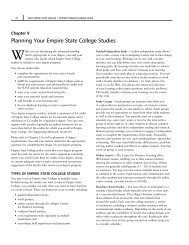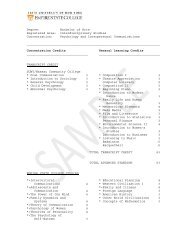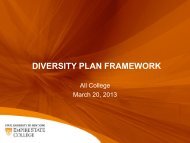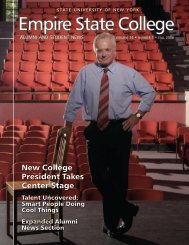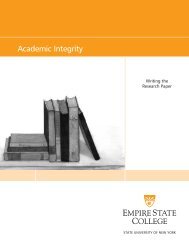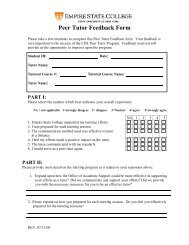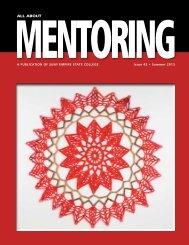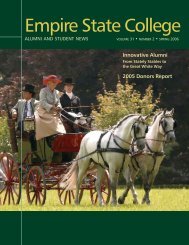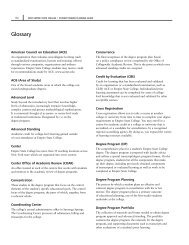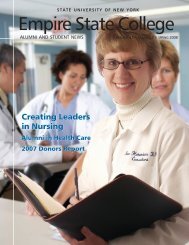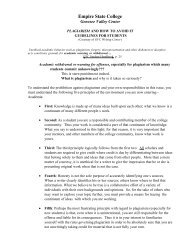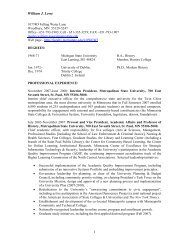Academic Plan 2011-2015 (PDF 524kB) - SUNY Empire State College
Academic Plan 2011-2015 (PDF 524kB) - SUNY Empire State College
Academic Plan 2011-2015 (PDF 524kB) - SUNY Empire State College
You also want an ePaper? Increase the reach of your titles
YUMPU automatically turns print PDFs into web optimized ePapers that Google loves.
36 <strong>SUNY</strong> <strong>Empire</strong> <strong>State</strong> <strong>College</strong>: <strong>Academic</strong> <strong>Plan</strong> <strong>2011</strong> - <strong>2015</strong>to address in a strategic manner the optimal configuration of faculty across all subject areasbased on anticipated trends in enrollment over the next five years. It also is critical to determinethe needs and roles of full-time faculty, or line-appointed part-time faculty, adjuncts andacademic professionals.Objective C1.3: Develop and resource a five-year plan for faculty hiringDeveloping a plan to hire faculty clearly must wait until the data have been analyzed, gaps identified,and opportunities for further growth evaluated. In addition, there are processes that must beaddressed in order to ensure that appropriate stakeholders have a voice in recruitment and hiringdecisions. For example, search procedures should be revised to make sure that search committees forfaculty positions which serve more than one program include appropriate members from the variousprograms. Procedures also need to be developed to support newly hired faculty in negotiating thecompeting demands of multiple programs, since learner success will depend on faculty success.Objective C1.4: Develop guidelines to integrate faculty planning into new academicprogram developmentPrograms that are proposed at any level of the college need to be vetted in light of faculty areasof expertise, needs across the college, anticipated and unanticipated workload requirements, andthe faculty hiring plan detailed previously. While the criteria for new program development includefaculty strengths, this section also recommends looking at a new program in the context of all of thecompeting roles and responsibilities of those faculty.A governance consultation process should be implemented to ensure that deans, executives, oranyone with an immediate need to act on a program opportunity presents his or her proposal to anappropriate academic body before extensive preparation moves forward. This group should be chargedwith ensuring adherence to the goals and plan identified previously, taking into account optimal facultyconfigurations, funding, effects on existing faculty and professional structures of shifting resourcesto new programs, optimal ways of carrying out mentoring/instruction, and related issues, as well asdeveloping a set of guidelines to integrate faculty planning into new academic program development.Goal C2: Support Faculty Development in Terms of Scholarshipand PracticeIn this section, we outline how the college might maintain and sustain faculty in developing the subjectmatter (both disciplinary and interdisciplinary) and practice expertise necessary to support existing andfuture academic programs in a variety of modes of learning.The challenge for faculty at our institution is that they must work to develop not only subject matterexpertise, but also expertise in adult learning; in practice-based knowledge (particularly in the primarymentoring role, that is, supporting students in the design of their own degree programs); knowledgeof the specific program(s) in which they work; and in the evaluation of experiential learning. Facultymust have sufficient facility with multiple technologies to support their work with students in a rangeof modes of learning. Some of this knowledge can be gained only through work in one’s program;other knowledge can be supported and shared more widely. The Center for Mentoring and Learning




